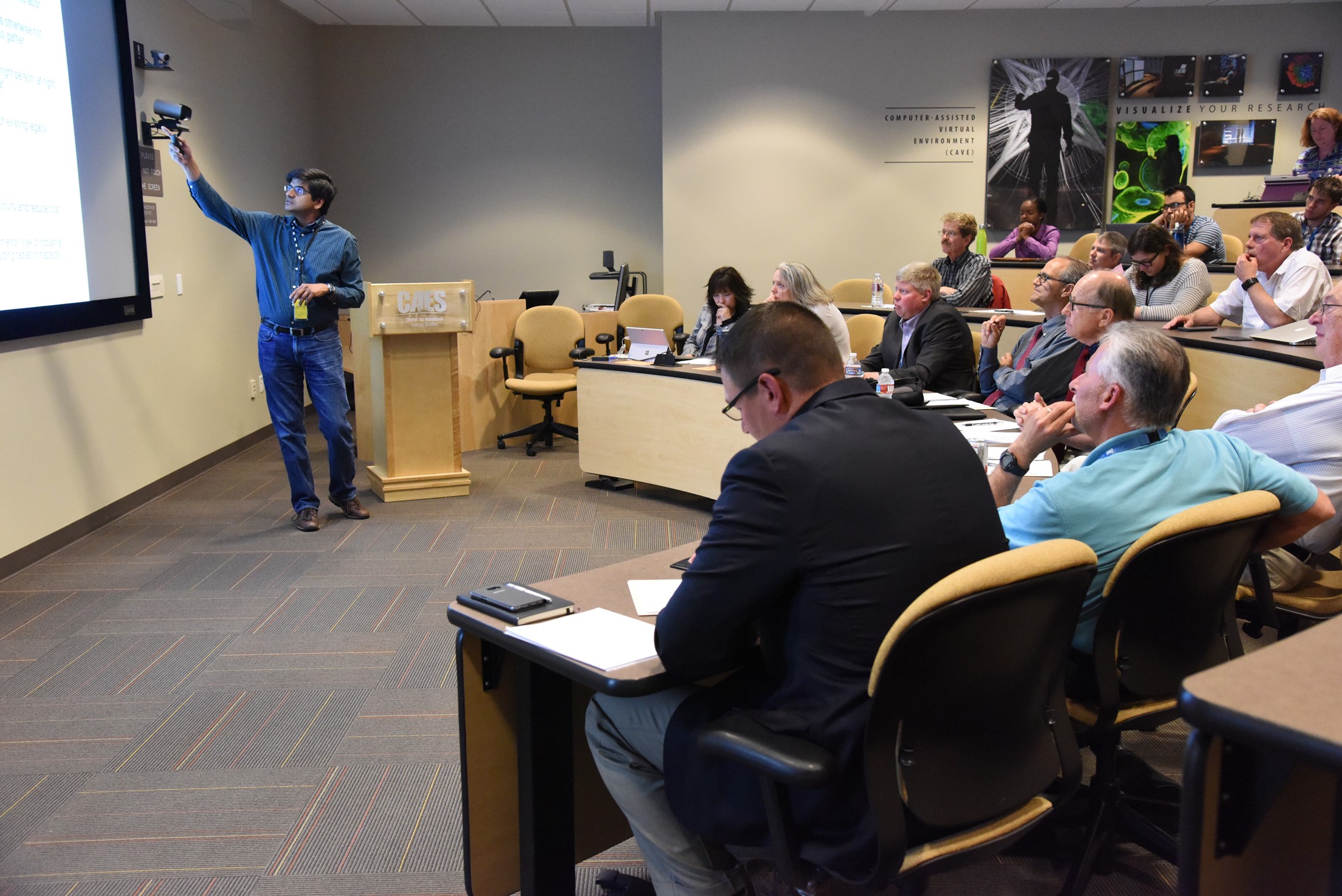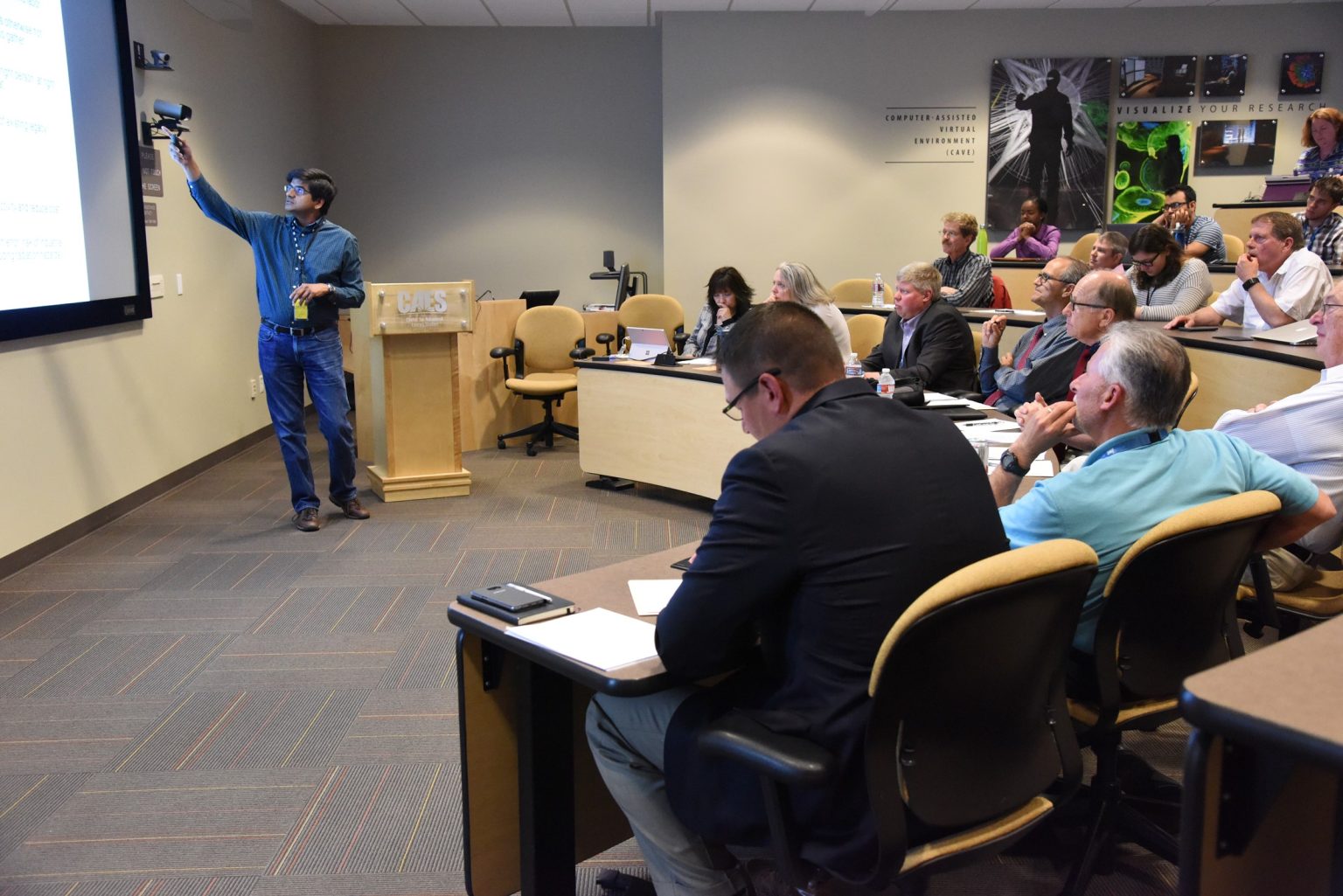Pitching a new business idea to investors does not come easily to most scientists and engineers. But for researchers at the Department of Energy’s national laboratories, it is an essential part of attracting industry partners and accelerating commercialization of new technologies.
DOE’s Energy I-Corps is an intensive two-month program that gives research teams the skills they need to locate customers, develop business models, and successfully promote commercially viable technologies. A team of Idaho National Laboratory researchers recently won second place in DOE’s National Lab Accelerator pitch contest following a first place finish in INL’s own National Lab Accelerator Pitch Competition held on June 30 at the Center for Advanced Energy Studies.
The INL research team, referred to as Team 4Cs, led by Dr. Vivek Agarwal and John Buttles, also participated in DOE’s Energy I-Corps full program (Cohort 6) in October and November 2017, partially based on their success in INL’s National Lab Accelerator Program (or the Lite program). Following that, in competition with National Lab Accelerator teams from nine other National Labs, Team 4Cs took second place on Nov. 29 at the National Laboratory Accelerator Pitch Competition in San Ramon, California, organized by Lawrence Livermore National Laboratory.
The four ‘Cs’ in the team name stand for communication, connectivity, coexistence and cybersecurity – attributes of the wireless valve monitoring technology the group developed. The technology, which enables online monitoring of manual valves in nuclear power plants through a system of small wireless sensors monitoring each valve, will significantly decrease labor costs for plant configuration management. It does this by allowing remote surveillance of manual valves in nuclear power plants, resulting in significant reduction of labor cost in day-to-day plant operations.
The award included $10,000 in prize money to support future technology development. First- and third-place awards went to teams from Lawrence Livermore National Laboratory and Sandia National Laboratories.
Developing the pitch
Earlier last year, the team led by Agarwal and Buttles took first place in INL’s own National Lab Accelerator Pitch Competition June 30 at the Center for Advanced Energy Studies. Last spring, Team 4Cs was one of 13 INL teams participating in the lab’s inaugural National Lab Accelerator program, nicknamed “Energy I-Corps Lite.” Six of those teams participated in the end-of-program pitch competition.
“INL’s Lite program helps familiarize researchers with the skills they will hone in DOE’s Energy I-Corps full program,” said Agarwal. “The Lite program helped us answer questions: Why is our technology important? How will it benefit industry?” Teams developed business models that helped them identify key partners, essential activities and resources needed to successfully commercialize and market their technology.

Like DOE’s full program, INL’s Lite program required researchers to conduct several customer discovery interviews. Early in the process, Team 4Cs spoke with Scot Greenlee, a senior vice president of Engineering and Technical Services from Exelon Nuclear Generation. He showed tremendous interest in their technology and provided an industry mentor, Dr. Uuganbayar Otgonbaatar, to be part of Team 4Cs in the Energy I-Corps full program (Cohort 6). Exelon operates 23 nuclear power reactors in the U.S.
“Dr. Uuganbayar brought valuable industry perspectives, things that John and I had never thought about.” said Agarwal. “He facilitated several industry conversations and helped us frame our interview questions.” Team 4Cs also included independent startup consultant Jessica Whiting and Mark Kaczor, INL Technology Deployment adviser.
On Nov. 9, Agarwal and Buttles visited Exelon’s Calvert Cliffs Nuclear Power Plant, where they were able to talk with operators, plant engineers and maintenance workers. “A priceless experience during the visit was seeing the expression on the fieldworkers’ faces when they realized that this technology would reduce or eliminate the need for them to go into tight, uncomfortable places or suit up to enter radiologically controlled areas,” Agarwal said. “They were excited about this solution.”
Buttles and Agarwal took all they had learned at the plant and incorporated it into their design and business model. Published data suggests that approximately two thirds (66 percent) of the cost of operating a nuclear power plant involves operation and maintenance expenses. The typical plant contains miles of piping, with approximately 150 to 200 valves that must be opened and closed manually. Verification of each manual valve position change is performed independently, meaning at least two workers must be present each time a valve is operated. By replacing manual verification with digital, the team’s technology may reduce plant downtime by up to one day per outage (at an estimated savings of $1 million/day); reduce personnel safety risks, including potential radiation exposure; and reduce the chance of human error.
INL filed a patent application for the technology in late December. Development of the technology is funded by the Department of Energy’s Office of Technology Transitions through the Technology Commercialization Fund program, and the Office of Nuclear Energy.
Swimming with the sharks
At the national pitch competition, teams presented to an audience of 33 experienced investors, tech leaders, mentors and judges. All commented on the high caliber of innovation in the technologies presented, the importance of the market problem being addressed, and the high quality of the presentations and skill of the presenters. Hannah Farquar of Lawrence Livermore (and one of the faculty members of Energy I-Corps Cohort 6) told Team 4Cs she was very proud to see how the team took the lessons learned in Energy I-Corps and incorporated them into their presentation.
“Walking into a room to present to tech giants, business leaders and venture capitalists definitely pushed me out of my comfort zone,” Agarwal said. “I’m comfortable presenting to fellow researchers – these folks were different.” Although the judges were there to critique the pitches, they were also there to help. One judge suggested that the team must consider taking the technology to other industries, such as oil and gas. “He said our business model is strong, but not applicable to venture capital investors unless it goes beyond nuclear,” Agarwal said.
Agarwal enthusiastically endorses the INL Energy I-Corps Lite program. “This entire journey – from Lite to I-Corps to the pitch competition – has strengthened an existing friendship/partnership with John, led to collaboration with industry leader Exelon, helped me understand what Tech Deployment does, and laid a foundation for partnership between INL and Exelon in this area of research,” he said. “The experience was invaluable.”
Energy I-Corps
Energy I-Corps, managed by the National Renewable Energy Laboratory, is an intensive two-month program of training and mentorship designed to give national laboratory researchers the tools, skills and experience they need to understand industry needs and become effective marketers for their technologies. During the two-month training, teams participate in workshops led by industry experts, and conduct more than 75 customer discovery interviews. Since 2015, 63 teams from 10 national laboratories have participated in Energy-I-Corps. The teams’ technologies have attracted nearly $10 million in follow-on funding. In addition to team 4Cs, INL has sent 14 teams through Energy I-Corps – more than any other national laboratory. Teams from nine national laboratories participated in the fall 2017 cohort.
INL Innovation Corps (formerly known as the “Lite” I-Corps Program)
INL I-Corps is a six-week project where INL researchers with a research concept (with associated intellectual property, patents and copyrights), develop a business value proposition, and validate it through numerous customer interviews (10 is the goal) with industry experts and end-users. The program also evaluates the practical business considerations that need to be evaluated when developing a technology, using a “Business Model Canvas” approach. Supplemental training also is offered for researchers not familiar with the above techniques.





